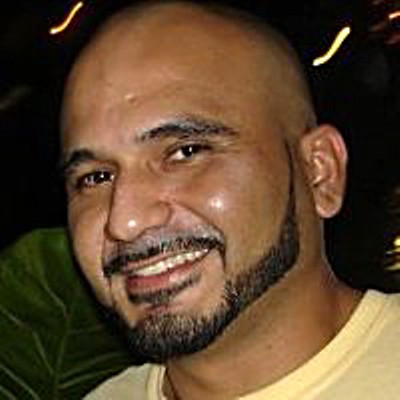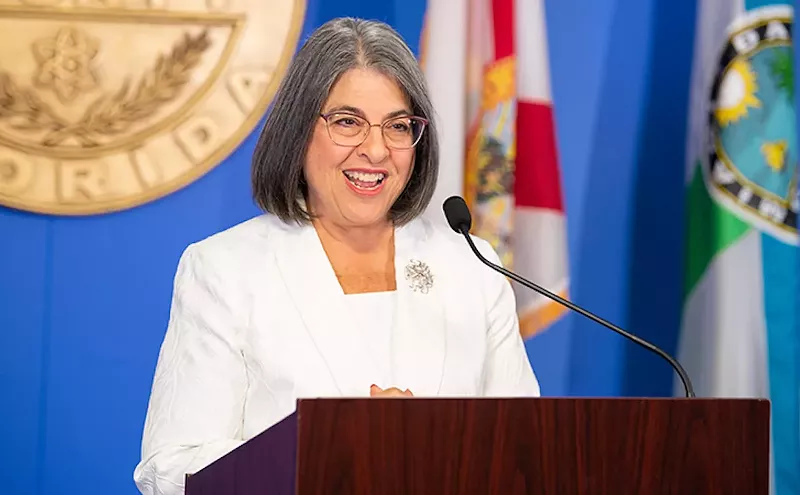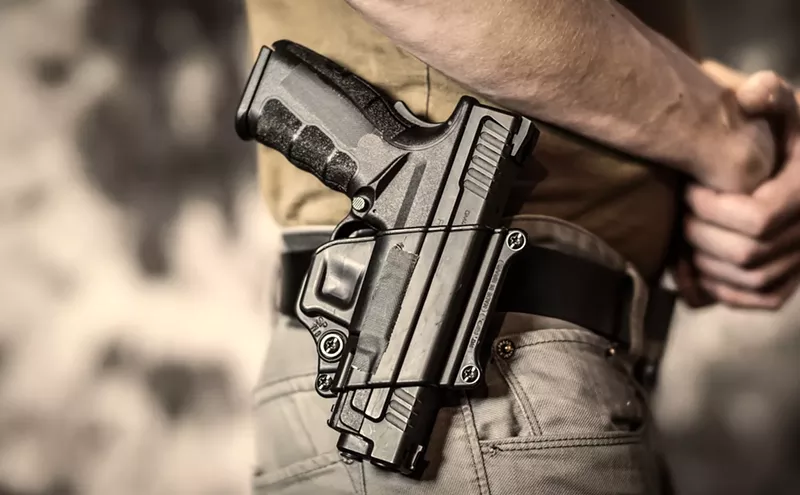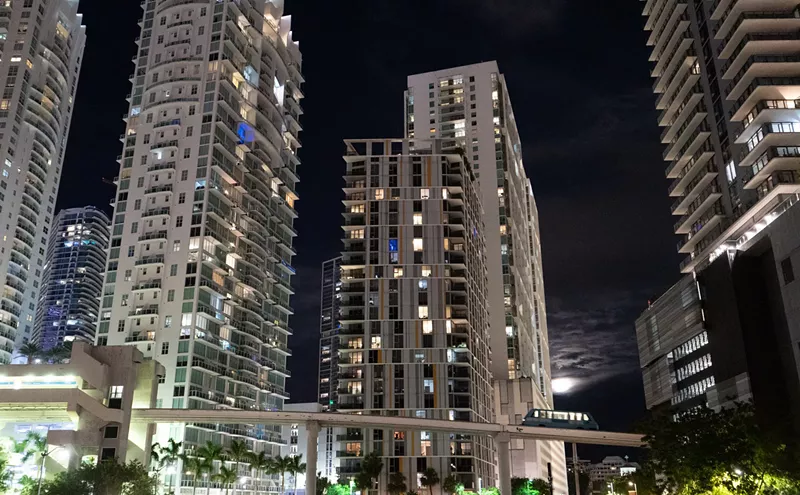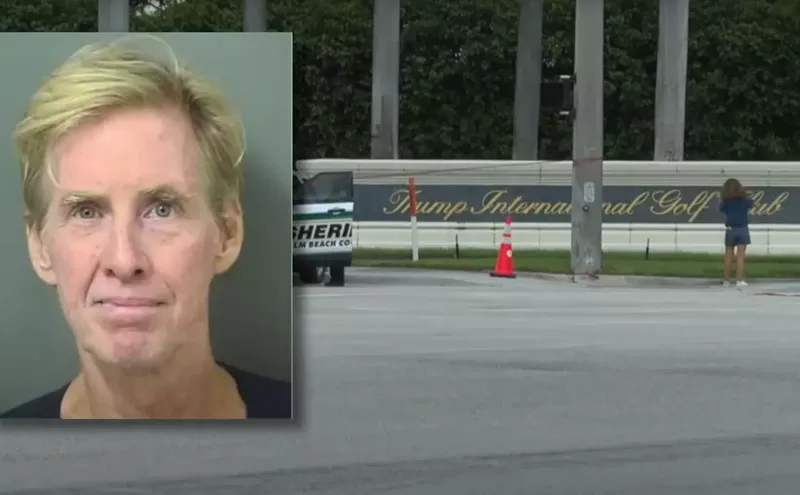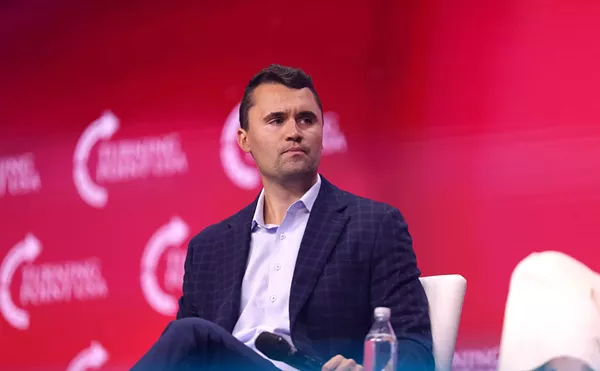Seth Levy is ripping it. The urethane wheels on his skateboard roar as the 23-year-old University of Miami graduate glides from the bottom to the top and back down the smooth concrete bowl carved into Bethune Point Skatepark in Daytona Beach. Shortly after noon October 15, this is the first stop of Levy's daylong road trip thrashing through two concrete skate parks located hundreds of miles north of the Magic City. His long, curly, sandy-blond hair juts out of his protective helmet and bounces with his every twist and turn. Sweat parades down his face and neck, soaking the top of his tie-dyed blue and purple T-shirt.
Levy finishes his run so his friend Robert "Bobby" Stack, a 45-year-old Yoda of the Miami skateboarder scene, can ride the bowl's perfectly curved walls. "Go for it!" Levy shouts. Stack, who rides a Santa Monica Airlines deck made for vertical skating, drops in. As he rolls into the bowl, Stack bends his knees like a seasoned surfer riding a high wave. In less than a minute, he pulls off 11 kick turns without falling off his board. "Yeah!" Levy gushes. "Woooo!"
In another area of the 35,000-square-foot park, Miami-based professional skater Paul Hurtado kick-flips his board over a sculpture called the "broken pyramid," which is part of Bethune Point's street course. The gangly 26-year-old Cadillac enthusiast lands perfectly on the stone floor. "Whoa... that was sick," says one of the half-dozen riders waiting for their shot to leap the pyramid.
For Levy, Stack, and Hurtado, Bethune Point is a luxurious skateboarders' oasis they would love to replicate in the heart of downtown Miami in order to avoid the four-hour, 256-mile trek to Daytona Beach. "The long ride and the 100 bucks in gas take the fun out of coming up here," Stack says. "I don't want to wait until I am 65 years old to see a true skate park get built in Miami."
Though there are no hard statistics to show skateboarding's local appeal, its popularity is undeniable, says Chris Williams, a 37-year-old skater who co-owns M.I.A. Skate Shop in Miami Beach and the indoor M.I.A. Skate Park in Doral, which opened in 2006 and draws 1,500 to 2,000 skaters a month who pay $7 to $10 each. Downtown Miami in particular is a mecca, where for more than two decades South Florida skaters have made the pilgrimage to catch air off the steps and grind on the railings of office and government buildings. "My business partner and I have been skating for 20 years," Williams says. "Miami is the best city to street-skate. Even to this day, kids come from as far as West Palm Beach to skate downtown."
Outdoor skate parks have also opened in Miami Lakes, Country Village, Coconut Grove, Palmetto Bay, and West Kendall. Through their nonprofit company, One Cool World, Levy and Hurtado manage the Grove park, where they estimate 200 to 300 skaters pay the $5 admission to thrash at the outdoor facility on weekends. On a recent Saturday afternoon at the park, a crew of four teenage skaters performs street tricks while another group rides quarter ramps. "We ride the Metrorail from the Martin Luther King station in Liberty City to the Grove station almost every weekend," says Corey Jackson, a 14-year-old thrasher. "I love skating."
Yet Levy insists none of the existing Miami-Dade parks, including the one in Coconut Grove on McFarlane Road, is built to the standards of Bethune Point, which is made of concrete. "The difference is huge," Levy notes. "The Grove park is falling apart. We have to invest at least $10,000 to replace the rotted wood on all our ramps."
Until this past June, it seemed Miami's skateboarding community would finally get its own concrete paradise at Biscayne Park, on NE 19th Street near First Avenue — a seldom-used, ten-acre, city-owned site sandwiched between Temple Israel and the historic City of Miami Cemetery, where city pioneers such as Julia Tuttle and the Burdine family are buried. The project's $2.2 million tab would be covered by the city's Omni Community Redevelopment Agency. But over the past six months, a group of politically influential synagogue members and historic preservationists has impeded the skate park's development through a public relations campaign that plays on the stereotype that skateboarders are hooligans bent on ravaging public and private property, even if it's sacred. "I think it is sacrilegious," says local black historian Enid Pinkney. "The whole skate park idea blatantly disrespects Miami's heritage."
"A skate park doesn't belong next to a historic cemetery," says Penny Lambeth, a Miami Lakes-based publicist and preservationist who has helped restore the burial grounds over the past two decades. "It is the final resting place for Miami's first everything, from the first mayor to the first black lawyer."
The opposition has bummed out Levy and his friends, who just want a place to skate where they won't be kicked out for doing an ollie off a building's front steps or arrested for vandalism for grinding on a bus bench. It's been especially frustrating for Levy, an enterprising young man who was involved in the development of 13 skate parks, including two in Israel, before he moved to Miami in 2006. "The park's opponents are pulling every political string to stop it," Levy grouses. "This has been a bigger hassle than I expected it to be."
To find out if the complaints against the skate park's location are valid, New Times tagged along with Levy, Stack, and Hurtado to Bethune Point, then Lawnwood Skate Park in Fort Pierce, and finally an empty swimming pool in Pompano Beach. Along the journey, we tracked the evolution of South Florida's skateboarding subculture and learned why a skate park tucked between a historic cemetery and Jewish temple wouldn't hurt anyone.
Levy sits yoga-style on his skateboard while taking a break from his Bethune Point run. He has swapped the helmet for a black mesh baseball cap that squishes his floppy, curly locks. "When I got to Miami, I was surprised that there were no real skate parks like this one here in Daytona," he says. "It sucks that we have to travel more than 200 miles to find one. Miami-Dade County has built three parks that are just awful and falling apart. The only skate parks that can last for a long time are poured-in-place concrete skate parks."
An upbeat Washington, D.C. Jewish kid with undergraduate degrees in entrepreneurship and religion, Levy stepped on his first board when he was 3 years old. "I would push around on it," he recalls, "and I was never able to stop after that." His skateboarding idols include Steve Caballero, an original member of skateboard company Powell-Peralta Bones Brigade; and Omar Hassan, one of the world's best bowl skaters and a regular X Games contestant.
Levy and his friends would ride their boards and public transit 20 miles to a popular skate park in Woodbridge, Virginia. When he was 13, the town closed the park, prompting skaters in the nation's capital to push local officials to build them a new public spot for miniramps, half-pipes, bowls, and street courses. "I helped on every aspect of the project, from fundraising to working with the local government," Levy recalls. "I learned how to find the best possible sites for a skate park, which are usually in urban, dense neighborhoods. And I learned how to deal with politics and the not-in-my-back-yard crowd."
By the time he graduated from D.C.'s Winston Churchill High School in 2006, Levy was involved in establishing free public skate parks in Arlington and Baltimore. He spent the summer in Israel, where he volunteered his input on skate park developments in Tel Aviv and Zichron Ya'akov, a town founded in 1982 by 100 Jewish Romanians. Levy notes his idol Hassan attended the grand opening of the Zichron Ya'akov skate park, which is coincidentally next to a synagogue. "I was so stoked," Levy recollects. "Here we had opened a skate park that welcomed everybody — Jews and Muslims included — in one of the most messed-up places in the world."
In fall 2006, Levy arrived in Coral Gables to attend the University of Miami. "With the great weather, I figured Miami was the perfect place for a skater to go to college," he says. "I was surprised to find out that this big metropolitan city didn't have a free skate park like the ones I skated back home."
One day during his sophomore year in 2007, he knocked on the office door of Lansing McLoskey, a 46-year-old music professor and pool skater, and asked him to be the skateboard club's faculty adviser. "From the moment I met him, I could see his ambition and his organizational skills," McLoskey says of Levy. "He is evangelical about skateboarding. He talked about building a ramp on campus and selling skateboard decks with the university's logo in the bookstores, which he ended up doing."
A year later, McLoskey learned via his neighbor, a Miami Park and Recreation employee, that the Omni CRA had allocated $1 million toward a $2.2 million plan to redevelop Biscayne Park, where today soccer aficionados play pick-up games on the weekend. The plan features a 16,000- to 24,000-square-foot skate park that would use about $700,000 of the total budget. The balance would bankroll new bathrooms, a park administration office, landscaping, fencing, parking, and lighting.
McLoskey informed Levy about the plan. The youngster acted quickly, contacting the park employee heading the project, Ralph Gonzalez; and city Commissioner Marc Sarnoff, who as the Omni CRA chairman fully supported the skate park idea. In 2008, Sarnoff tapped Levy to serve on a park committee to study the skate facility's configuration and on a bid selection committee tasked with choosing a contractor to build the park. "I am not tied to any design companies," Levy says. "One reason I got involved is to make sure the city builds the best possible skate park."
But some of the folks opposing the skate park's location question the skateboarding ingenue's seemingly innocent intentions. Temple Israel's past president Stanley Tate, a wealthy real estate developer who started a college scholarship program for underprivileged kids, accuses Levy of having a conflict of interest because he owns two properties one block west of Biscayne Park. According to Miami-Dade County property records, Levy purchased a three-bedroom duplex at 67 NE 19th St. for $100,000 in July 2009. Seven months later, he bought a two-bedroom house at 85 NE 19th St. for $70,000.
Tate says he met Levy one time at the office of downtown Miami capital fund manager Peter Bermont, another synagogue member with clout. "This young skater was pretty cocky about his role with Sarnoff," Tate claims. "He said he had bought the two vacant houses and that he was going to build a facility to sell skateboards and accessories. I was shocked."
Bermont concurs. "The young man knew what was going on before anyone in the public did when he bought the properties," he says. "If you have information before anyone else, doesn't that give you an edge?"
Tate says he offered to buy the two parcels from Levy. "I never heard from him," he adds.
The straight-edged skater, which means he doesn't use drugs or drink alcohol, admits he contemplated redeveloping one of the properties into a community center for skateboarders to hang out. "I don't think having me or someone like the guys at M.I.A. Skate Shop set up a retail center is necessarily a bad thing," Levy says. "In fact, it would generate tax revenue for the city. But I don't want to ruffle any feathers, so I have no intention of changing the zoning on either property."
The structures, which Levy eventually had demolished, were overrun by crackheads and prostitutes. "I found needles and used condoms all the time," he complains. "I had a homeless guy chilling on the second floor of one house. He offered me heroin."
Levy plans to build a new home if the project moves forward. "My only conflict of interest is raise my property's value," he says, "and that I have always wanted to live next to a skate park."
"How would you like to visit a dead relative and hear kids with boomboxes and smoking marijuana, because that is what they do in the park." Tate, the Miami skate park location's number one hater, is being interviewed by WPLG-TV Local 10. It's June 30 at 11:15 p.m., and the gruff 82-year-old, dressed in a white-and-black checkered jacket and black tie, is cramming as much opposition as he can into the two-minute segment.
An influential real estate developer credited with pushing through state legislation that in 1987 created the Florida Prepaid College Plan, Tate has been on a mission to kill the skate park since facing off against Marc Sarnoff in December 2009 at Temple Israel. "The commissioner told me he didn't care who I was," Tate says. "He was real obnoxious and nasty. I've worked with presidents Clinton and Bush. Neither of them has ever acted the way Sarnoff does. He wants everyone to kiss his ring."
Tate, who contributed $100,000 to the Republican Party and GOP candidates in 2008, wasn't about to back down from the city commissioner. The old man loves a good scrap. Last year, he took on the state legislature, Gov. Charlie Crist, and 11 state university presidents to stop tuition increases. He spent $500,000 of his own money on ads against the hikes.
During a telephone interview with New Times, Tate stands by his generalization of skaters that was tailor-made for the evening news. "I absolutely meant it," he says, noting he and Bermont stopped by the Coconut Grove skate park, which coincidentally is operated by a nonprofit company that lists Levy as a director on its state corporate records. "Not only did I see boomboxes, I heard them," Tate hisses. "There is no question about the marijuana because I could smell it."
(New Times visited the park on three separate occasions in October, staying two to three hours each time. Levy and Hurtado allowed hip-hop music to be played, but the noise didn't travel past the basketball courts next to the skate park. Though most of the teenage riders skated without adult supervision, parents accompanied children under age 10. And we didn't see anyone inside the skate park lighting a spliff or a pipe.)
Following the WPLG story, other concerned citizens joined the synagogue's opposition. One of them was Miami Lakes-based publicist Penny Lambeth, who sprang into action after receiving a Google Alerts message about the news story during the Fourth of July weekend. Born and raised in Columbus, Ohio, Lambeth migrated to Miami 30 years ago. She graduated from Ohio State with a degree in journalism but made her career in public relations. "I came for a vacation and just fell in love with the city," she says. "I got involved with local preservation groups because I am a big history buff."
Lambeth has been a member of the Dade Heritage Trust as well as the Villagers, a Coral Gables historic preservation group, for more than two decades. During a face-to-face interview, Lambeth rattles off the restoration projects for which she has volunteered: Venetian Pool, the Gusman Center, Actors' Playhouse, the downtown Miami civil courthouse, and the Merrick House, among others.
But her most cherished project has been the City of Miami Cemetery, where city founders such as Mary Brickell, Henry Flagler, and Julia Tuttle are entombed. As chairwoman of the City Cemetery Task Force, Lambeth led the charge in 1998 to clean up the then-101-year-old burial ground.
An elderly woman with white-blond hair and a voice as tender as sweet corn, Lambeth recalls how she pushed city officials to clear out a homeless encampment in the 10.5-acre cemetery, where burials began in 1897. "They had set up an entire living room behind some hedges," Lambeth says. "They were washing their clothes in the faucets and hanging their clothes to dry on tree branches."
She was also instrumental in securing a $110,000 federal grant that was used to build an eight-foot-high steel fence and install lighting. For the past decade and a half, Lambeth adds, she has gathered her preservation buddies to plant trees and spread fresh mulch three or four times a year. She has also led efforts to place grave markers for the African-Americans laid to rest in the segregated part of the cemetery.
The CRA's plan to convert the city-owned lot next door into a skate park has left her flabbergasted. In Lambeth's view, skaters fall into the same social category as the vagrants she chased out 12 years ago. "I'm not saying all skateboarders are bad," she says. "But the majority I have seen invite graffiti and vandalism. That is unacceptable next to a historic cemetery."
Lambeth, who also questions why the city would reduce green space to spend $700,000 on a concrete skate park, quickly mobilized her coalition, which includes former Sen. Bob Graham, car dealership mogul Norman Braman, and Miami historians Paul George and Enid Pinkney, who is head of the Dade Heritage Trust's African-American Committee. Pinkney doesn't mince words about the controversy. "I think the city can find another spot for the skate park," she says. "They just don't want to. It is a lot easier for them to disrespect Miami's history."
Using her skills as a publicist, Lambeth bombarded local media outlets, including New Times, with news releases announcing the unified front against the Miami skate park. To cast her ominous PR message, she emailed stock images of skateboarders standing before graffiti-covered walls while smoking cigarettes. In some instances, her pitch succeeded. An August 22 Miami Herald article played up Lambeth's negative slant, citing the closure of a skate park in Bridgewater, Massachusetts, after vandals set fires there.
To counter the attacks, Levy has been supplying reporters and city officials with research that pretty much debunks the opponents' main objections. Lambeth acknowledges Levy met with her and Pinkney to show them skate parks built next to cemeteries in Piedmont, California; Fayetteville, West Virginia; Medford, Oregon; and Independence, Missouri. "He was very nice," Lambeth says. "He offered to get the skaters to volunteer at the cemetery, and he probably would. But bringing all that concrete to a public park is just not a good idea. Why not take it to a warehouse or an abandoned shopping mall or an underpass?"
A white Chevy work van rumbles north on I-95 just past Exit 205C as the sun breaks over the horizon on the east side of the highway. Levy, with a black mesh baseball cap covering his clean-shaven, cherubic face, snores atop a burgundy-and-gold floral-print bench in the back of the van. Skateboards of various shapes and protective helmets lie scattered on the floor.
A metal grate separates the hull from the front cabin, where Stack sits behind the wheel. Pink Floyd's "Comfortably Numb" softly plays on the CD player. The Miami Norland Senior High alum's intense blue eyes peer at his side mirror, where he spots Hurtado tailing him in a silver Cadillac STS sedan. "I see he decided to leave the Escalade at home for this trip," Stack cracks.
Born and raised in Miami, Stack began riding in 1973, when he was 8 years old. He's considered old-school, a guy who skates only ramps, bowls, and empty pools. "I don't like my feet touching the ground when I skate," Stack explains. "I'm not the greatest and I'm not the worst skater out there. But I can ride on any type of skateboard."
Die-hard skaters such as Stack spend almost every free moment riding a deck. The desire to land a trick is addictive. At a skate park like One Cool World, it's not unusual to see a teenage boy spending four hours practicing a backside ollie over a street ramp or doing a 360-degree turn at the top of a quarter-pipe. For Stack and his young compatriots, skateboarding is a way of life.
Stack began riding when skateboarding was emerging as a sport in Florida and California, birthplace of the Z-Boys, a group of Santa Monica surfer-skaters that pioneered the sport in the early '70s. Stack was part of the South Florida scene that produced legendary Skateboarding Hall of Famers such as vert king Robbie Weir and Mike McGill, inventor of a 540-degree aerial skate trick dubbed the McTwist. Both guys were members of the Bones Brigade, a skate team sponsored by Powell-Peralta, the largest skateboard company during the '70s and '80s. Stack would run into the two Brigadiers and other pioneers such as Alan "Ollie" Gelfand — the Hollywood, Florida skater who invented the ollie — at the Runway in Perrine. Nicknamed "the Kinkway" because of its bumpy transitions, it was the first and biggest skate park in the Miami area until it closed in 1980.
Nine years later, Stack was living on South Beach and running his own company, Waiters on Wheels. "I loved it," he says. "I got to skate from 10 a.m. to 2 p.m. for work, and when I was finished, I got to skate the empty pools of the vacant hotels on Collins Ave. It was a real gnarly experience, dude."
Stack parks the van on a grassy lot near the entrance to Lawnwood Skate Park in Fort Pierce. "Now this park is awesome," he says as he climbs out of his ride. Levy, ready to go after his power nap, opens the side door and leaps out. "Lawnwood is definitely one of my favorite parks in Florida," he says.
Four years ago, during a nighttime downtown Miami skate session he had organized, Stack met Levy for the first time. "We instantly became friends," Stack says. "He is one of the most mature kids I have ever met in my life. You expect college kids who skate as much as he does to flunk out. He is a tremendous workaholic."
Hurtado pulls his Caddy behind the Chevy. "I don't think I am going home tonight," he quips as he surveys the skaters performing tricks on the roller-coaster stone landscape.
If Stack represents the early days of skateboarding, Hurtado embodies the reckless attitude of the modern-day street boarder. He sports a platinum watch on his left wrist and a gold timepiece on his right. He wears baggy black jeans that hang ridiculously below his waistline and an oversize red T-shirt emblazoned with the logo of his skateboard company, Amaxon. "Skateboarding" in neat cursive lettering is tattooed on his right forearm; the other forearm reads, "For Life." He owns a skate shop in Hollywood and, along with Levy, manages the Coconut Grove skate park.
"Skateboarding is my lifestyle," Hurtado asserts. "It is a fantasy world where I can do whatever I want and still be a successful businessman."
As the three skaters don their protective gear, Stack urges Hurtado to try bungee skating. "Have you ever seen a jet shoot off an aircraft carrier?" the regal skater asks his younger peer.
"Yeah, I am not down with that," Hurtado retorts. "I'll stick to handrails and ramps."
When he gets on the subject of skateboarding, Stack speaks with the tender touch of a Buddhist yogi, passing on more than a quarter-century of knowledge to cats like Levy and Hurtado. "Skateboarding has always been considered antisocial by the mainstream," Stack sermonizes. "But every skater rolls with a crew, which is just another four-letter word for team. Just like baseball and soccer, there is a structure to skateboarding that makes it a real sport."
Ten minutes before 7 p.m. on October 15, Stack parks his Chevy next to another white van in the driveway of a single-story house in Pompano Beach. A thin, middle-aged man with shoulder-length brown hair and bushy eyebrows greets Stack and Levy as they put on their helmets and grab their boards. "Wait till you see what is in the back yard," Kurt Massinello says. "You guys are in for a treat."
The trio strolls through the home's wood gate to find Massinello's 15-year-old son, Titus, riding the walls of an empty kidney-shaped pool. "Oh, man, Paul is going to be so disappointed he stayed up in Fort Pierce," Levy remarks. "This is going to be the highlight of the road trip."
For the next half-hour, Levy, Stack, Massinello, and his kid take turns catching air. The home's owner, Claude, who asked that his last name not be used, watches the skaters have their fun. Massinello informs that Titus competes in national invitationals. "We are forced to find empty pools or travel outside of South Florida because there are no proper skate parks for him to practice at," Massinello says. "I knocked on Claude's door four months ago. He let me pump the dirty water and scrape the sludge out so we could skate it."
Stack and Levy give the pool their seal of approval. Once the session is over, Levy reveals that the skate park controversy had him contemplating leaving his new hometown. "Now this was fun," Levy says. "Finding this pool may convince me to stick around."


